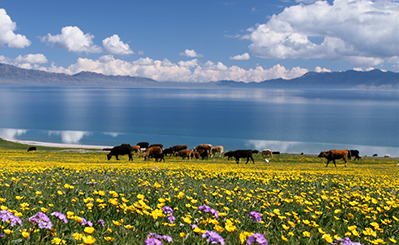Desert areas transformed into lush landscapes
Nestled deep in the heart of the Taklimakan Desert, often referred to as the "place you can enter but can't exit" in the Uygur language, lies an extraordinary botanical garden.
The Taklimakan, China's largest desert, is also known as the "Sea of Death" and has remained an inhospitable land for a long time. Yet the Tazhong botanical garden, sprawling across more than 20 hectares, is home to over 230 plant species.
The architects of this botanical marvel are a group of dedicated researchers. Thanks to their unwavering efforts, the ecological environment of the desert has undergone fundamental transformations.
In 1991, the researchers established a botanical testing base on the fringe of the desert to conduct pioneering experiments on cultivating plants through saline-alkali water irrigation, according to Chang Qing, the senior engineer at the Xinjiang Institute of Ecology and Geography under the Chinese Academy of Sciences who designed the Tazhong botanical garden.
Three years later, as the desert road extended into the heart of the Taklimakan in Tazhong township, researchers from the institute relocated their research base to this remote location.
Decades have passed, and what was once barren land has transformed into lush forests. The plants cultivated here have not only contributed to ecological protection efforts across Xinjiang but have also ventured beyond borders, supporting desertification control projects in Africa, Central Asia and other regions.
On the northern edge of the Taklimakan lies the Aiximan Lake area, located in Awat county, Aksu prefecture. Previously plagued by desertification, soil erosion and wetland degradation, the lake area in the western part of the Aksu River Basin was once inundated by windblown sand.
Today, it is a lush landscape, with expansive forests standing tall and lucid rivers meandering along the forest perimeter.
The transformation began in 2021 with Aksu's ecological restoration and desertification control project. Harnessing recycled water resources from the prefecture and Wensu county, the project utilized artificial irrigation as its central strategy to establish an ecological protection forest. This was complemented by the cultivation of economic and timber forests.
The region regenerates approximately 50 million cubic meters of water annually, supporting the irrigation needs of more than 33,000 hectares of ecological restoration forests.
"Sandstorms no longer plague Aksu like before. The number of dusty days has diminished in several of our towns, leading to a reduction in areas affected by sand and dust," said Jiang Lili, deputy director of Awat county's forestry and grassland bureau.
"Most importantly, we no longer experience sandstorms."
Moving farther south to the edge of the Taklimakan in Lop county, Hotan prefecture, one can witness the production of green energy. The Lop photovoltaic power station, with a total capacity of 200 megawatts, began operating in February.
Operated by the State Power Investment Corporation, the power station is estimated to produce an average output of 360 million kilowatt-hours annually, equivalent to saving 110,000 metric tons of standard coal and reducing carbon dioxide and nitrogen dioxide emissions by 330,000 tons and 1,300 tons, respectively.
"Located at a relatively low latitude, this area enjoys long hours of sunshine, with hardly any rainfall throughout the year," said Tian Juxiong, the station manager.
The vast expanse of golden sands in the Taklimakan is slowly evolving into a powerful catalyst for sustainable development in Xinjiang.
Desert tourism has become another testament to the shifting mindset of people in southern Xinjiang.
Makit county in Kashgar prefecture serves as the "gateway" to and from the Taklimakan, boasting one of the most abundant desert tourism resources in China. Thousands of adventure enthusiasts flock here from May to the end of October each year.
According to data from the regional culture and tourism department, during this year's May Day holiday, Xinjiang received about 8 million tourists, a 141 percent increase compared to the previous year, and achieved tourism revenue of 6 billion yuan ($840.62 million), up 192 percent year-on-year.
 Attractions
Attractions Dining
Dining Culture
Culture